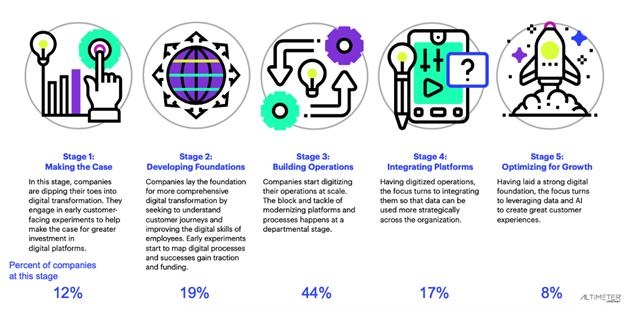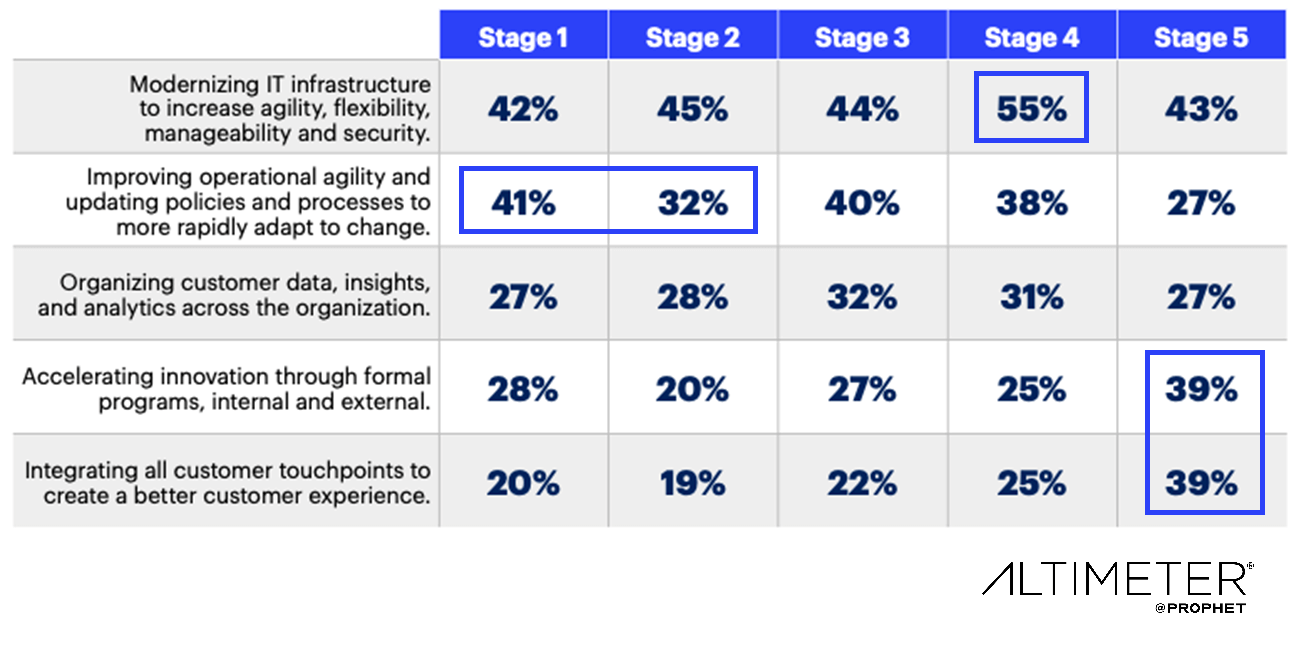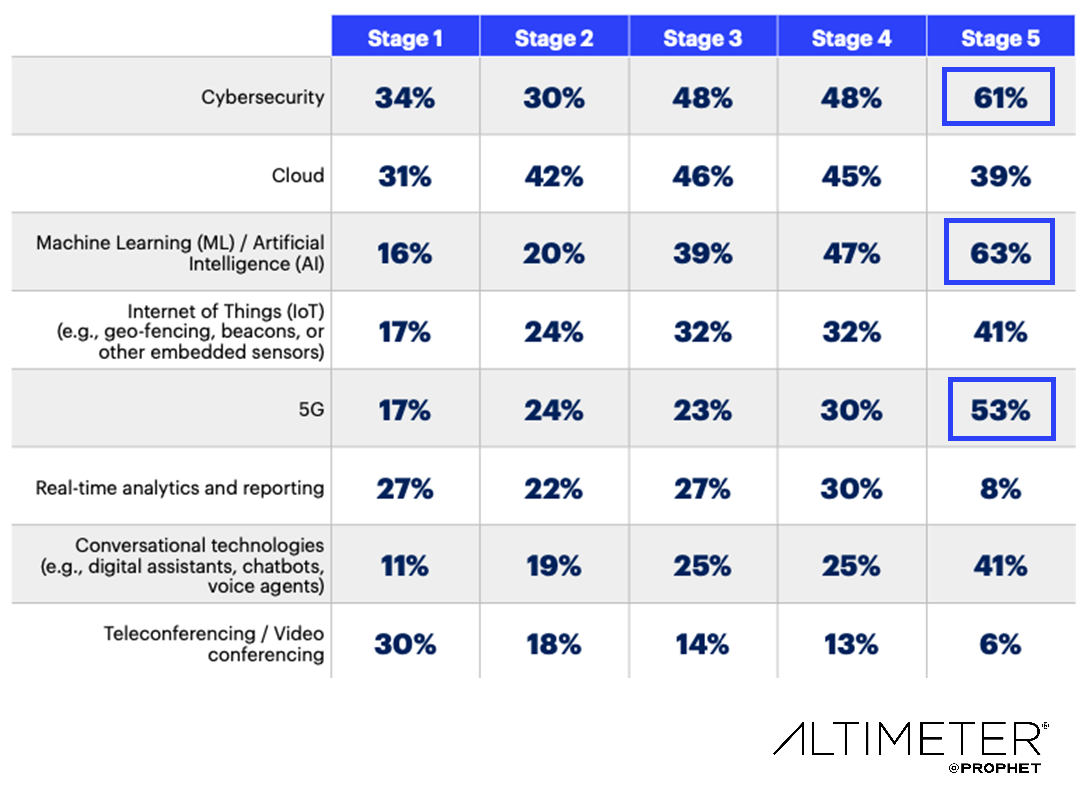Digital transformation doesn’t mean what it used to. In fact, the term, as it’s been used to describe so many corporate efforts over the last 20-plus years, means something different today: Building digital businesses. And that goal is very much alive.
Today, when companies talk about digital transformation, it’s because they want to find new ways to use technology to serve customers better. They hope to build business engines that continually reinvent themselves. They understand “transformation” isn’t an endpoint but a state of constant evolution.
Businesses also know that the need is urgent. Research from Altimeter, a Prophet company, finds that 92% of leaders believe their current business model won’t remain viable if digitization continues at current rates. However, many companies are conflicted about how to transform.
It doesn’t help that digital transformation conjures images of expensive failures. According to a 2019 study, companies like General Electric, Ford, Procter & Gamble and others have sunk up to $1.3 trillion in digital transformation efforts, and about 70%–roughly $900 billion–was wasted.
But the consequence of not pursuing digital transformation is worse. Almost every recent notable bankruptcy–from Toys R Us to Hertz to Frontier Communications–is linked to failure to transform.
Typically, efforts fail because those in charge keep insisting that digital transformation is rooted in technology. That’s where people get it wrong: digital transformation is based on people and enabled by technology. More specifically, initiatives collapse because leaders don’t approach their strategy with the right mindset. In the race to find easy wins and weak consensus, they focus on tech-driven tools and tactics rather than what these tools are in service of. They also skip the three most important conversations required for successful transformation:
What Are Our Goals?
For the many companies that lurch from one quarter to the next, articulating a bold vision is difficult. And even for those skilled in adaptive business strategies, following customers in wholly new directions is daunting.
But it’s essential. Transformation can only succeed when leadership sets a clear, measurable vision for how digital will transform the business. Further, executives must do more than simply state their transformation agenda. They must champion the initiative and hold everyone accountable for their part in creating the necessary capabilities, products and services to bring that vision to life. Transformation cannot happen in silos. It must reach across the entire business and be embedded in all functions for real change to happen.
This is inherently risky. Nike’s 2017 decision to use digital muscle to connect directly with consumers meant ditching large wholesale customers. To some, that seemed reckless. But it paid off: its share price has nearly tripled since, and Nike continues to be one of the most fast-moving, beloved brands in the world.
Goals should be specific, and they must acknowledge the need to move at two speeds, with short-term optimization and long-term iterative capability building.
“Digital transformation is based on people and enabled by technology.”
Electrolux, for example, knew consumers wanted every aspect of their home to be connected. It not only included the appliances they use but the way they shop for them. So, the company set goals to make digital integral to every phase of the customer journey. This required a dedicated cross-functional executive team, including marketing, product, sales, IT and critical markets.
These solutions are, of course, tech-enabled. By developing marketing mix guidelines that optimized spending by brand, product and channel, Electrolux improved its operating margins by nearly 20% in just one year. But these changes grew from a deep understanding of people’s preferences and the explicit goal of transforming a manufacturing business into a consumer marketing-driven company. Like Nike, Electrolux has become a more people-focused enterprise that’s turned it into a relevance-seeking machine, always in motion and constantly evolving.
How Do We Find the Capabilities To Get There?
A new digital business requires new capabilities. Companies must confront the question of how they will obtain these new skills. Will they build them? Buy them? Partner with another company?
Consumers think of Starbucks as a coffee shop. However, Starbucks has long known that it can only fulfill its purpose if it puts the right technology in the hands of both customers and baristas. Consistent investment in loyalty and payment systems has paid off in a digital universe that now powers 50% of U.S. sales. with a quarter of sales from mobile devices. For Starbucks, building that proprietary technology was the right path. Tech has even become a revenue source on its own, with the company now licensing systems to international franchisees.
Acquisition is another route, sometimes chosen by some of the most innovative companies. That includes Apple, which recently bought Mobeewave, a payments company based on nearfield communication, rather than build its own. Even digital natives need help given the pace of change in customer expectations.
All three approaches may make sense, depending on an organization’s near-term goals and long-term ambitions. Deciding among these options requires a candid assessment of current organizational capabilities and what it will take to achieve them.
What Do Our People Need To Take Us There?
Organizational change is always tough and managing for digital transformation is even harder. If companies want people to work and think differently to transform the business, they can’t expect them to do it on demand. Behavior and mindset are emergent. Organizations need to enable the workforce with the right skills to create value, whether through upskilling or temporary support.
This requires evolved governance and tools that make it easy for them to do the right thing for the new strategy, and in the right way. Incentives must be realigned to give people space for experimentation, so they can navigate the ambiguity that comes along with almost all transformation strategies.
To do this right, most companies will require a complex revaluation of their capabilities, governance systems, talent mix and employee value proposition. They need new recruiting, retention and incentive practices as they prepare for the future and must enlist a diversity of talent that is new to them. They need short-term innovators and long-range thinkers, fast movers and patient tinkerers. Transformation requires a cultural revolution, hiring new types of people and skillsets, and then leading them differently.
At Prophet, we talk about the “body, mind and soul” of an organization; and that to digitally transform, a business needs to address all these elements. In Prophet’s Human-Centered Transformation Model, an organization first determines what it wants its DNA to be – its purpose, its brand proposition and its strategic plan to win. Next, it goes to work on the “mind” (its talent, capabilities, and skills), the “body” (governance, process and tools) and the “soul” (its values, behaviors and rituals).
All are necessary for the digital transformation to have its full impact.














